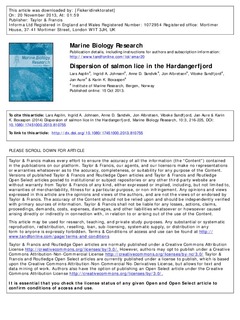| dc.contributor.author | Asplin, Lars | |
| dc.contributor.author | Johnsen, Ingrid A. | |
| dc.contributor.author | Sandvik, Anne Dagrun | |
| dc.contributor.author | Albretsen, Jon | |
| dc.contributor.author | Sundfjord, Vibeke | |
| dc.contributor.author | Aure, Jan | |
| dc.contributor.author | Boxaspen, Karin | |
| dc.date.accessioned | 2013-11-20T10:04:17Z | |
| dc.date.available | 2013-11-20T10:04:17Z | |
| dc.date.issued | 2013-10-15 | |
| dc.identifier.citation | Lars Asplin, Ingrid A. Johnsen, Anne D. Sandvik, Jon Albretsen, Vibeke Sundfjord, Jan Aure & Karin K. Boxaspen (2014) Dispersion of salmon lice in the Hardangerfjord, Marine Biology Research, 10:3, 216-225 | no_NO |
| dc.identifier.uri | http://hdl.handle.net/11250/109098 | |
| dc.description.abstract | The abundance of salmon lice in the Hardangerfjord is potentially large enough to be a threat to the wild fish stocks of the fjord. The salmon louse spends a period of 2–4 weeks in its planktonic stages drifting in the current of the upper water masses of the fjord looking for suitable hosts on which to settle. It is important to assess the abundance and distribution of the lice in their planktonic phases in order to evaluate the infection pressure they represent to the wild fish. The current system of the upper water masses in the Hardangerfjord is highly variable and consists of a multitude of components. This implicates a similar variability of the salmon lice dispersion. We find the most efficient transport mechanism for planktonic salmon lice to be from internal pressure due to lateral variations of the water mass density. From current observations we find large water exchanges of the upper water masses in the fjord lasting for several days, approximately monthly. Numerical model results indicate that these exchange episodes extend for the whole length of the fjord. Hence, the salmon lice will be regularly transported several tens of kilometres. We find the influence area of salmon lice from a source to be potentially large as a small number of lice can cover large areas. However, the majority of the lice will stay relatively close to the source but not necessarily with the highest abundance in the source area. We also find aggregations of lice in certain areas, typically close to land and in bays. | no_NO |
| dc.language.iso | eng | no_NO |
| dc.publisher | Taylor & Francis | no_NO |
| dc.title | Dispersion of salmon lice in the Hardangerfjord | no_NO |
| dc.type | Journal article | no_NO |
| dc.type | Peer reviewed | no_NO |
| dc.subject.nsi | VDP::Agriculture and fishery disciplines: 900::Fisheries science: 920::Fish health: 923 | no_NO |
| dc.source.pagenumber | 216-225 | no_NO |
| dc.source.volume | 10 | no_NO |
| dc.source.journal | Marine Biology Research | no_NO |
| dc.source.issue | 3 | no_NO |
| dc.identifier.doi | 10.1080/17451000.2013.810755 | |
